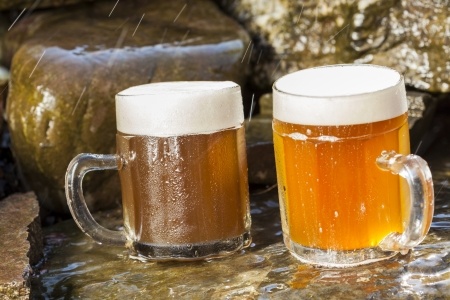Ethnicity is a key to the history of Denver, and at the center of ethnicity are the saloons each group established, clustered around Larimer St.
There’s no better way to get a feeling for the origins of this town than via a history of Denver, as it relates to drinking. Early residents of Denver, no matter their ethnic origins, enjoyed a good beer. While all groups enjoyed beer, they enjoyed it most in the company of their own ethnic group, where they could relax and enjoy the comfort of their native languages and cultures.
Originally part of the Territory of Kansas, what became the Denver area was sparsely settled until 1858, when three different groups established settlements in the area. General William Larimer, a land speculator from eastern Kansas, jumped the St. Charles claim and staked his own one-mile square claim, renaming it “Denver” after the governor of the Territory of Kansas, James Denver.
Although Denver didn’t “pan out” as a mining community despite an initial flurry of activity, it grew rapidly as a supply hub once the Gold Rush began. General Larimer’s claim, and the saloons around Larimer St., were at the center of activity as immigrant communities found themselves at home in them. Various ethnic groups “relished their taverns as ethnic clubs and community centers for a wide range of social, political, and economic activities.”
By 1880, more than 1/3 of Denver saloons were German-owned. Inside these establishments, “customers could speak and sing German, enjoy German music and dance, read German newspapers and magazines, procure strudel and sauerkraut, and quaff German beer and wine.” The best-known of these German establishments was Turn Hall, established in 1889.
Germans were wealthy and politically powerful in Denver and enjoyed great influence until first, Prohibition in 1916, then World War II, diminished their influence. Because of their wealth and prominence in the saloon business of Denver, Prohibitionists targeted them, and many Germans lost their jobs in the liquor industry. Irrational hatreds related to the War made life even more difficult for Denver’s German population.
Nonetheless, Denver benefited from German music and culture — and enjoyed Bock Beer Day. In 1874, “Otto Heinrich ‘s saloon at Sixteenth and Larimer set the record for Bock Beer Day, serving some 3,000 glasses of beer, 50 loaves of bread, and 125 pounds of meat.”
Many Irish arrived as part of the railroad crews and settled in working class neighborhoods near the tracks. Also well-received, Irishmen soon established bars strategically placed between their homes near the tracks and their jobs. Irish saloons promoted Irish clubs and organizations, Gaelic literature, lectures and band music and distributed the Rocky Mountain Celt, the “only” Irish-American newspaper in the West.
By 1900, the Irish were less than 3% of Denver’s population, but they owned 10% of the bars. Irish political clout came from a triangular partnership between saloon owners, politicians and policemen. “Saloon-keeping Irish councilmen included James Doyle, John Conlon, Andrew Horan and William Gahan. Of these bartending aldermen, one of the most successful and long-lived was Eugene Madden. Madden served nine consecutive city council terms with strong support from his Larimer Street saloon and the nearby police department, where his brother was a captain.”
Like other ethnic groups, Jews found the liquor business relatively easy to enter. Albert Wongrowitz’s popular saloon and delicatessen, located next to a synagogue, was one of the first sources of kosher food. Despite anti-Semitism, Jewish immigrants, many originating from Germany, were successful in Denver. The fact that Denver elected a Jewish mayor in 1889 signified a relatively easier integration process. Blacks, Asians and Italians suffered from more violent and intensive discrimination.
Italians, recruited as cheap labor for the railroads and other industries, suffered from a more unwelcoming reception in Denver, but they, too, eased their entry by establishing saloons that served them as cultural centers.
Starting in tents and shacks in the bottomlands, and operating grocery carts and businesses, Italians, with the help of more well-established compatriots with whom they connected in the Italian saloons, eventually achieved success and moved into the tree-shaded neighborhoods of north Denver. Here they established popular restaurants and bars. Italians, who viewed consumption of alcohol as healthy, were largely unaffected by Prohibition, simply moving into their basements.
Finally, the Slavs (Czechs, Slovaks, Slovenians, Serbs, Croats, Poles, and Russians, including many Russian Jews and non-Slavic Germans from Russia) established a significant community in Denver. By 1920, the Russians became the single largest group immigrating to Colorado.
The Slavs settled in Globeville, the smelter factory town just north of Denver. As had other ethnic groups before them, the Slavs enjoyed their many saloons in Globeville, not only for the beverages but as community centers. Like the saloons in other poor areas, these also served as banks.
Among the many cultural institutions that immigrant groups brought to Denver, saloons were perhaps the most numerous and conspicuous. They played a key role in bringing their customers into American life and into the life of the city. Few immigrant taverns reappeared after Prohibition, but the effects of these influential business qua community centers remain.
In 1988, it became legal in Colorado to produce and sell beer to retail customers on the same premises. The WynkoopBrewing Company ran a close race against Carver Brewery to claim the title as the oldest micro-brewery in Denver.
John Hickenlooper, founder of the Wynkoop Brewing Company and now governor of the state, looks back on those anxious early days. He remembers the all-consuming effort required to open Wynkoop first, which it did on October 18, 1988, selling 6,000 cups of beer at 25 cents each.
Today Denver continues to enjoy its beer in its many micro-breweries. For more information or to schedule a micro-brewery tour, please contact us.

